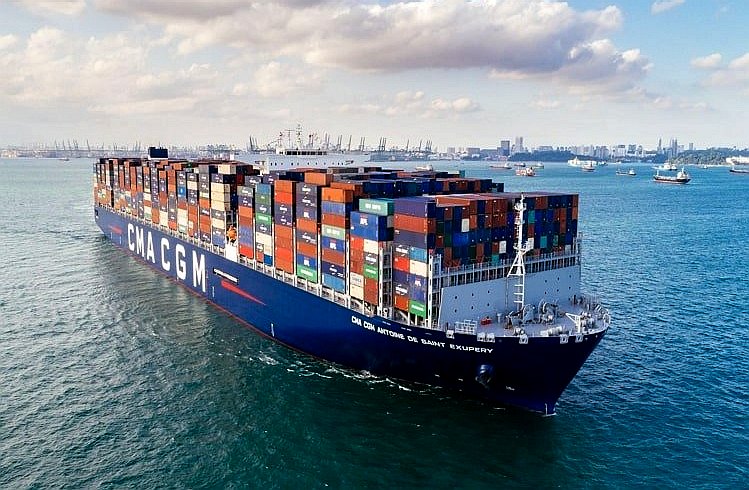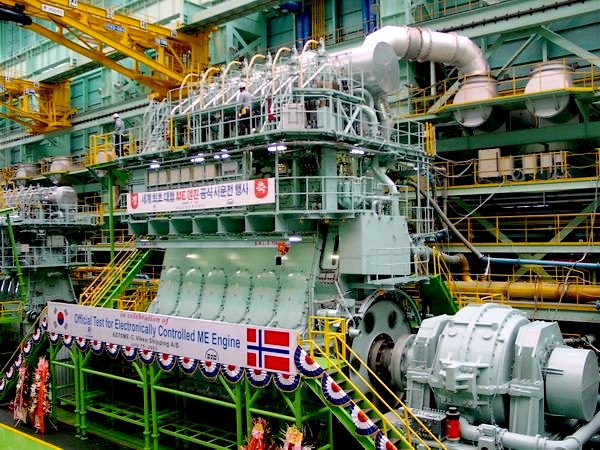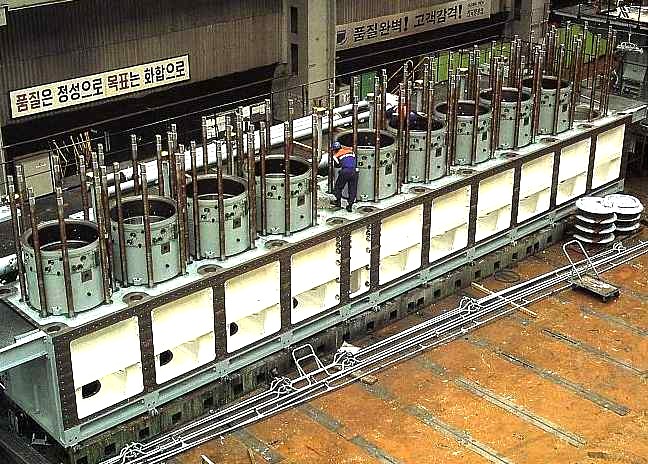|
CMA CGM ANTOINE St. EXUPERY 4th
ABOUT - CLIMATE CHANGE A-Z - CIRCUMNAVIGATION - CONTACTS - DONATE - FOUNDATION - HOME - OCEAN PLASTIC A-Z Please use our A-Z INDEX to navigate this site
CMA CGM ANTOINE de SAINT EXUPERY - This mammoth fossil fueled vessel entered service in 2018.
4. CMA CGM ANTOINE de SAINT EXUPERY
Named to tribute famous French writer and aviator Antoine De Saint
Exupery, this is the biggest containership flying the French
flag as of October 2019. Built by the Hanjin Heavy Industries and Construction
in the Philippines, it is a vessel with exceptional dimensions: 400-meter long and 59-meter wide; 20,954 TEUs capacity; dead-weight of 2,02,684 MT.
She is powered by a Winterthur Gas & Diesel model X92 low speed diesel engine, with a power output up to 73,560 kilowatts (98,650 hp) that can propel her at up to 22 knots (25 mph). She has a capacity of 20,954 TEUs and
emits about 3 grams of CO2 per km and per tonne.
CMA CGM S.A. is a French container transportation and shipping company. It is a leading worldwide shipping group, using 200 shipping routes between 420 ports in 150 different countries, ranking fourth behind Maersk Line, MSC and COSCO. Its headquarters are in Marseille, and its North American headquarters are in Norfolk, Virginia, United States.
STANDARD
Modern containers ships are cargo ships designed to carry their cargo in standardised steel boxes, using a technique called “Containerization”. This type of ocean transport contributes about 90% of non-bulk cargo movement worldwide. This is how you get your televisions, computers, fruits and spare parts. Cars are generally transported by ferries, though some collector vehicles are delivered in containers.
Fossil fuelled container ships that belch clouds of fumes as they ply the ocean may one day be a thing of the past. Shipping will continue without those who fail to adapt to changing circumstances such as global warming and zero carbon fleets by 2100, as part of the IMO's ocean cleanup objectives. In the meantime here are the top ten biggest gas guzzlers and potential ocean polluters in the world @ October 2019.
Why
Are They So Big?
The use of fossil fuels raises serious environmental concerns. The burning of fossil fuels produces around 21.3 billion tonnes (21.3 gigatonnes) of carbon dioxide (CO2) per year. It is estimated that natural processes can only absorb about half of that amount, so there is a net increase of 10.65 billion tonnes of atmospheric carbon dioxide per year. Carbon dioxide is a greenhouse gas that increases contributes to global warming. A global movement towards the generation of low-carbon renewable energy is underway to help reduce global greenhouse gas emissions.
SIX STEPS TOWARD A COOLER PLANET
1. TRANSPORT: Phase out polluting vehicles. Governments aim to end the sale of new petrol, and diesel vehicles by 2040 but have no infrastructure plan to support such ambition. Marine transport can be carbon neutral with development..
2. RENEWABLES: Renewable energy should replace carbon-based fuels (coal, oil and Gas) in our electricity, heating and transport.
3. HOUSING: On site micro or macro generation is the best option, starting with new build homes to lock carbon.
4. AGRICULTURE: We need trees to absorb carbon emissions from a growing population, flying, and to build new homes. Reducing food waste and promoting less energy intensive eating habits such as no meat Mondays.
5. INDUSTRY: Factories should be aiming for solar heating and onsite renewable energy generation.
6. POLITICS: - National governing bodies need to adopt rules to eliminate administrative wastages, to include scaling down spending on war machines, educating the public and supporting sustainable social policies and financing that mesh with other cultures.
These marvels of engineering excellence got us where we are today, technology wise, but threaten to destroy the planet if we do not adapt in time to repair at least some of the damage we have done.
FOSSIL
FUEL HEALTH HAZARDS
One of the world's largest diesel engines being assembled in Japan.
1995 COP
1,
BERLIN, GERMANY
2022 COP 26 - Will they have applied the brakes?
LINKS & REFERENCE
https://en.wikipedia.org/wiki/Fossil_fuel https://www.studentenergy.org/topics/fossil-fuels
EXTINCTION OF SPECIES - From blue planet to scorched earth because vested interests prevented politicians from putting the brakes on. Economics stopped them thinking about the safety of life on earth, including the future of our children. They'd rather die richer, than live, gambling with the lives our their offspring and every other species on planet earth.
Please stop playing with fire, there is no Planet B.
HOW MUCH IS THE EARTH HEATING UP - As of early 2017, the Earth had warmed by roughly 2 degrees Fahrenheit (more than 1 degree Celsius) since 1880, when records began at a global scale. The number may sound low, but as an average over the surface of an entire planet, it is actually high, which explains why much of the world’s land ice is starting to melt and the oceans are rising at an accelerating pace. If greenhouse gas emissions continue unchecked, scientists say, the global warming could ultimately exceed 8 degrees Fahrenheit, which would undermine the planet’s capacity to support a large human population.
This website is provided on a free basis as a public information service. Copyright © Cleaner Oceans Foundation Ltd (COFL) (Company No: 4674774) 2019. Solar Studios, BN271RF, United Kingdom. COFL is a charity without share capital.
|


